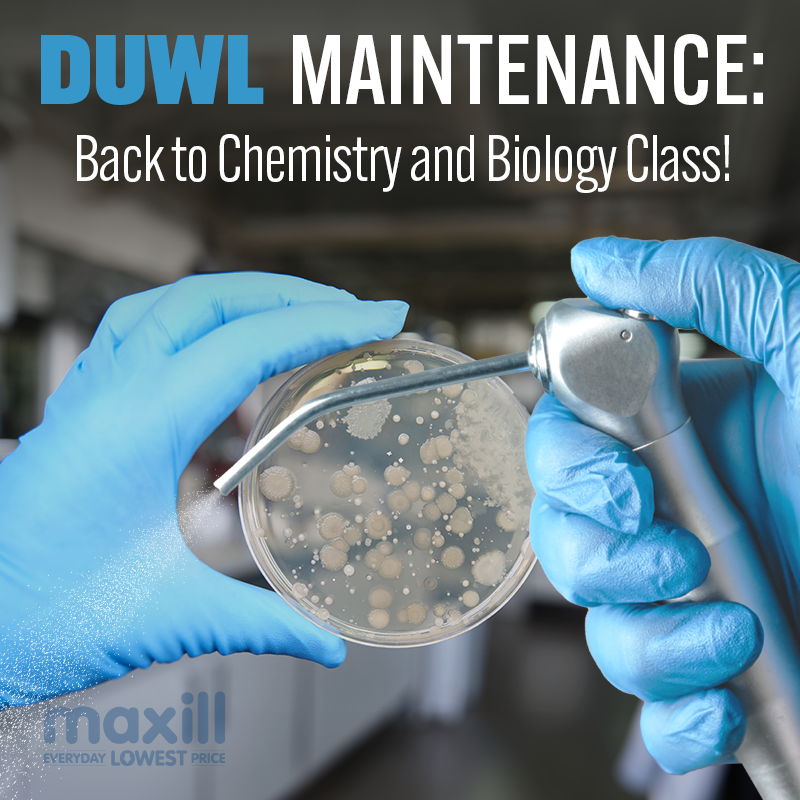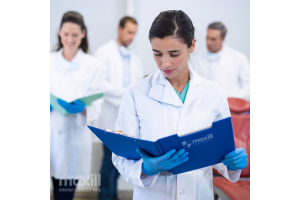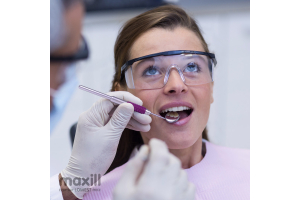Unlocking the Science of Dental Unit Water Line Maintenance: A Chemistry and Biology Lesson for Your Dental Office

DUWL Maintenance: Back to Chemistry and Biology Class!
No matter what geographical area a dental office is in, it MUST have a Dental Unit Water Line (DUWL)maintenance program. Who says? Is it the dental regulatory bodies? Is it the manufacturer of the dental chair or bracket table that hosts DUWL’s? It’s both! The dental regulatory bodies state to observe the manufacturer’s instructions for use (MIFU). Perfect, so then we head over to the MIFU and what does it state? Low and behold as clear as day we need a program that includes cleaning, disinfecting, and testing.
How do you clean the inside of one of the smallest tubes possible?
With enzymes that can attack the biofilm and destroy its matrix. The inside of the DUWL is a hard surface. We are all educated in the rules of cleaning and disinfecting that employs the sequence of cleaning then disinfecting. If the bioburden is not removed from the surface the disinfecting chemicals will not perform to their intended level. Obviously, we do not use an enzyme cleaner on our counter tops, but we use elbow grease! We use mechanical movements with pressure. Since we cannot get our hands or a tiny little scrub brush inside the DUWL we rely on the mechanical force of enzymatic activity. Another analogy could be as simple as washing dishes but not removing the food on the plate. Makes no sense right? The outcome of the plate cleaning would be poor with food debris everywhere. Same applies to the DUWL hard surface. Without the cleaning step there is still debris sitting on the surface of the line. The cleaning step is the most missed step in the DUWL equation.
What about the water tablet placed in the bottle?
Does it offer any cleaning properties? If you use the water tablet you don’t need to do anything else right? Incorrect.
The water tablet offers the following:
- Persistent bacteriostatic properties provide proactive waterline maintenance
- Helps control microbial contaminants in dental unit waterlines
- Will not impact dental equipment or affect dental procedures
- Eliminates odour and foul-tasting bacteria
Do you see ‘cleaning’ or ‘disinfecting’ listed? No and that is because the tablet does not clean or disinfect. The most common mix up of products is the water tablet being a start to finish solution. As you can see it is not. It’s part of the equation but alone it does nothing for the biofilm in the DUWL. Its job is to take care of the water in the closed water system’s bottle. Nothing more, nothing less.
What are the characteristics of a quality disinfectant for DUWL?
Well, one that disinfects, not one that cleans. A disinfectant that offers both cleaning and disinfecting will have limitations on destroying the biofilm. Why? We just established the bioburden needs to be removed before the disinfectant can jump in and work its magic. How can the product clean and disinfect at the same time? In the theory of cleaning and disinfecting these are two individual steps that must occur in proper sequence to yield the desired outcomes. Just like cleaning, disinfecting requires a mechanical action. We don’t just glide over the hard surfaces as a gentle sweep with our disinfectant wipes, we apply pressure and get into all the nooks and crannies with the wipes. How do you get into all the nooks and crannies in the tiny diameter of the DUWL? Again, we can’t get our hands in there with a wipe or a brush to deliver the disinfecting chemicals. We then need to select a chemical that will do it for us, one that will offer a mechanical action.
What chemical is well known for its bubbling, foaming action?
Hydrogen peroxide. It’s a well-known disinfectant. What if the Hydrogen peroxide were paired with another chemical to give a gigantic ‘fizzing’ action? Hmm, even better for the outcome of reaching the full surface area of the tiny tube. What other chemical would make an ideal ally to hydrogen peroxide, another strong oxidizer? For the chemical enthusiasts the question could be posed as what substance can remove electrons from another reactant in a redox reaction and on top of that has a molecular entity capable of donating a hydron to an acceptor? What about peracetic acid (a.k.a peroxyacetic acid or PAA)? PAA is a big shot in the periodic table of elements as it is an organic compound of carbon-hydrogen that upon oxidization breaks down into acetic acid, water, and oxygen. Well done PAA for being so environmentally friendly!
The testing portion of the DUWL regimen does not employ the need to research chemicals per say but it does require to step back into high school biology class. Think about a petri dish with an agar base. We placed a culture or sample to test for potential growth of bacteria on the agar plate. Agar feeds the microorganisms. What does agar have to do with DUWL water testing? Place a sample of your DUWL water exiting the DUWL onto an agar medium, incubate 24-48 hours and wait to see what grows! Easy and let’s face it, it’s extremely fun!!!! Can a dental office using an agar dip slide culture system be as precise as measuring colony forming units (CFU)? No but close enough.
Dental office water testing systems are referred to as hygienic monitoring systems employing the use of legends and tables to compare to CFU. Aiming for a CFU comparative value under 500. A value of 250 is a better approach because getting to close to the 500 count leaves very little to no room for correction time.
In conclusion, DUWL maintenance is a task no dental office can ignore or dodge. When the topic is approached from a chemistry and biology overview it allows dental professionals to make a better-informed decision on product choice to structure a DUWL maintenance program that is efficient in destroying biofilm, environmentally conscious, and cost effective. What if I were to tell you disinfecting your DUWL is potentially as cheap as $49.99 per year? Thirteen cents a day to have all this chemistry and biology fun in your office and be IPAC compliant … worth it!!!












